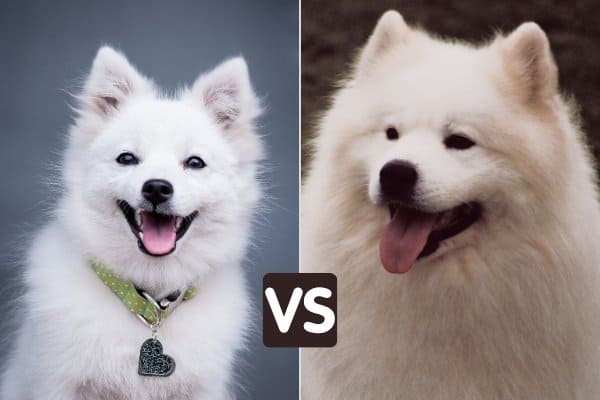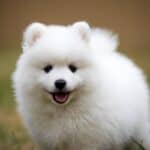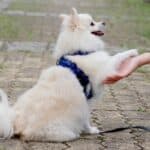If you are in love with the idea of a white, fluffy, smiling dog, both the Japanese Spitz and the Samoyed have probably come up on your radar. Both of these dogs make wonderful pets but for very different owners.
What are the biggest similarities and differences between the Japanese Spitz vs. Samoyed? Both the Japanese Spitz and the Samoyed are white, fluffy, and adorable. They differ in their size, color, trainability, exercise needs, and overall commitment to their care and upkeep.
Samoyed and Japanese Spitz both have devoted fans for good reasons, but they’re right for different kinds of owners.
Be sure that you know what’s under the fluff when deciding which of these breeds is right for you.
Comparison Table
|
Trait |
Japanese Spitz |
Samoyed |
| Size | 12 – 15 inches | 21 – 23.5 inches (male), 19 – 21 inches (female) |
| Weight | 20 – 25 pounds | 45 – 65 pounds (male), 35 – 50 pounds (female) |
| Life Expectancy | 12 – 14 years | 12 – 14 years |
| Breed Purpose | Companion | All-purpose working dog |
| Coat | Thick and plush, slightly softer | Thick and plush |
| Colors | White | White, cream, biscuit, biscuit and white |
| Grooming | Brush regularly, bathe infrequently | Brush regularly, bathe infrequently |
| Shedding | Profuse year-round, but especially twice a year | Profuse year-round, but especially twice a year |
| Training | Eager-to-please, highly motivated | Independent, mischievous |
| Friendliness | Happy, loving, outgoing, gregarious | Gregarious, outgoing, friendly |
| Exercise needs | Energetic and active, but can entertain themselves indoors | Significant vigorous exercise daily |
Japanese Spitz & Samoyed Similarities
Coat
Both the Japanese Spitz and the Samoyed have lush, double coats. These breeds have a soft, dense undercoat and a long, harsher guard coat.
The undercoats shed profusely year-round. The shedding is especially intense twice a year when the dogs “blow their coats.”
Between the Japanese Spitz vs. Samoyed, the Japanese Spitz has the slightly softer coat, but they may drop hair more readily.
Grooming
Despite having light-colored fur, both of these breeds repel dirt and mud.
If they get wet and muddy, just wait for them to dry. Once their coats are completely dry, you will be able to brush most of the dirt out. Alternatively, let them have a good roll in the snow.
These breeds do not need to be bathed very often. In fact, bathing too frequently can make them lose natural oils and can irritate the skin. They should only be bathed a couple of times a year.
Brushing, on the other hand, is a regular part of your life with either the Japanese Spitz or the Samoyed. Get ready to spend several hours per week brushing.
When these dogs blow their coats, you can expect to spend hours every day trying to get control of the fur.
They can be prone to matting, especially if the fur frequently gets wet. They should be brushed out from the skin regularly.
Use a long-toothed comb and make sure that you are getting all the way down to the skin. The more frequently these dogs are brushed, the easier it will be on you and the dog.
Ideal Climate
Both the Japanese Spitz and the Samoyed evolved in very cold climates. Those fluffy coats weren’t developed just to look adorable. They have an important job of keeping these dogs warm even in sub-zero temperatures.
Therefore, it should not be a surprise that these dogs don’t do well in warm climates. They can overheat easily. Additionally, too much sunlight can scorch their coats, ruining the perfect white or cream.
If you are considering having one of these dogs in a warmer climate, provide enough temperature-controlled space to give them sufficient exercise.
The little Japanese Spitz can generally get enough exercise indoors, but unless you have a lot of room, Samoyeds would be better in colder climates where they can get their exercise outside.
Friendliness
If you’re comparing the Japanese Spitz vs. Samoyed for their social characteristics, neither the Japanese Spitz nor the Samoyed will make an effective guard dog.
Samoyeds can have an intimidating appearance due to their large size and impressive mane.
Nevertheless, they’re sure to give themselves away with their ear-to-ear grin and wagging plume tails.
Both Japanese Spitz and Samoyed are known for being very friendly and gregarious dogs.
They generally do well with other dogs too, but it may be best to make sure that other dogs are at least as large as they are. Some may have a prey drive which may be extended to smaller dogs.
Japanese Spitz vs. Samoyed Differences
Color
Both the Japanese Spitz and the Samoyed are light-colored dogs with pure white being a standard and common color.
However, the Japanese Spitz can only come in the purest white, whereas Samoyeds can also be cream, biscuit, or white and biscuit.
Diet
Samoyeds can sometimes be prone to obesity. This can be hard to spot because the plush coat may hide the excess weight.
Carefully monitor your Samoyed’s diet to be sure that he’s not gaining too much weight. Many may do well on a managed, weight-control diet.
On the other hand, the Japanese Spitz is an energetic little dog that tends to wear out just living their highly active lifestyle indoors. They’re best managed on a high-quality food twice a day.
Exercise
Both the Japanese Spitz and the Samoyed are energetic dogs, but their differences in size means that your experience in providing the most efficient exercise will be very different.
Japanese Spitzes are companion dogs. They are happy to be with you and do whatever you are doing.
Running around in the yard or inside the house will provide enough exercise for many of these dogs.
A short daily walk when the temperatures are cool enough is plenty to wear out the average Japanese Spitz.
If your dog needs more exercise, they typically do well to entertain themselves with their toys inside.
On the other hand, the Samoyed is a large, powerful dog who was bred to pull sleds, drive livestock, and protect homesteads both day and night.
Most can settle down into family living without too much trouble, but they will need a lot of exercise to be happy.
Training
The Japanese Spitz is an intelligent companion dog who loves to interact with and please their owners. This makes them very easy to train.
Most are easily motivated by treats or toys. Many Japanese Spitz are happy to work for their owners just for the pleasure of their company.
Samoyeds were bred to think for themselves. When they weren’t pulling a sled, Samoyeds often foraged for food themselves and used their own intelligence to protect their people.
They lived with their people on their own terms in many ways. Samoyeds love their family and many would very bravely protect their loved ones.
However, they are not particularly eager to please or easy to train.
It is important to learn how to motivate your Samoyed puppy early and maintain consistent training throughout his life, but you may not be able to get this dog to excel at obedience.
Ideal Home for a Japanese Spitz
A Japanese Spitz might be right for you if…
You Have Lots of Time for a Dog
While the Japanese Spitz vs. Samoyed may not consume a lot of your energy in training or exercising, these are dogs who long to be with their people.
If you intend to leave your home, be ready for your Japanese Spitz to complain if he doesn’t get to come along.
You Don’t Mind Some Fur
If you have a fit when you see a fur flurry, the Japanese Spitz is probably not the breed for you. These dogs shed profusely and need a lot of brushing.
Get ready to lint roll the couch and invest in a robotic vacuum if you are bringing a Japanese Spitz into your home.
You Live in a House or an Apartment
The Japanese Spitz does well indoors most of the time in either a house or an apartment.
Provided you keep your home at a comfortable temperature and play with your dog inside, they’re happy just about anywhere.
Ideal Home for a Samoyed
A Samoyed might be right for you if…
You Enjoy Outdoor Exercise
If you want a Samoyed, you should be able to visualize them with you hiking, jogging, and generally enjoying the great outdoors.
These dogs crave exercise and thrive in the outdoors.
Your House Has a Backyard
It’s best never to leave a Samoyed unsupervised in the backyard. Still, most Samoyeds enjoy running freely, especially if there is some snow.
Since they can’t be trusted off-leash, a house with a big backyard is a good choice.
You Don’t Need a Highly Trainable Dog
Your Samoyed will love you and your family, but don’t expect them to wait on your every command. These dogs have their own minds and are very curious about their worlds.





